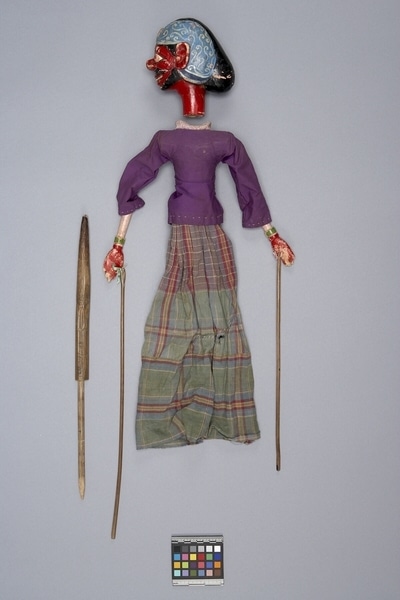Rod Puppet Item Number: Ib350 from the MOA: University of British Columbia


Description
Three-dimensional male humanoid puppet: large head (part b) fits into body with shirt and skirt (part a), and a control rod (part c) with a long shaft that passes through the body and fits into the neck of the figure's head. The body has jointed arms, each with a long controlling rod attached. Red face tilted upwards; bulging white eyes with red irises, raised ears, blunt triangular nose, and black hair, moustache and beard. White teeth. Hair net in Javanese style (Hoofddoek); blue with light blue designs, black main section. Slim body clothed in purple close-fitting jacket with white yoke collar that has purple and pink dots and evident stitching. Skirt (kain) of checked cloth (green, blue, purple, yellow, white). Arms with pink and green ornaments at wrists and biceps; hands held flat and bent back at wrist.
History Of Use
Javanese puppetry as an art form probably developed by the 11th century. Wayang golek puppets of western Java appeared during the 16th century. Originally the plays depicted Javanese mythology, but after the Indian conquest of Java the Hindu epics, Ramayana and Mahabharata, were incorporated into the cycles, which comprise about 200 plays. A dalang (puppet master) performs the plays to celebrate important occasions, usually in three acts, with vocal and instrumental accompaniment. Typically they serve a moral and religious purpose, and more recently, one of political commentary. Citraksi is a prince (raden) from the Mahabharata cycle of legends, which details the conflict between the Pandawa brothers and their usurpers, the Kurawas. Citraksi is known as a particularly aggressive Kurawa.
Cultural Context
Theatrical performance.
Iconographic Meaning
Each puppet is characterized by it's wanda, a Javanese word which describes the specific mixture of elements of size, form, colour, ornamentation and carving. Red face, eyes are negative, implying aggressiveness or assertiveness. Position of face, eyes imply irreverence or spiritual contrariness. Hairnet a less traditional form, usually found on minor princes (raden). Close-fitting clothes suggests a certain wealth. Garments also more modern; skirt not very refined. Headdress, shape of nose and face identify character as Citraksi, although some variation is noted.
Item History
- Made in Java, Indonesia
- Owned by Tradewind Antiques before March 15, 1983
- Received from Museum of Anthropology Shop Volunteers (Funding source) and Tradewind Antiques (Seller) on March 15, 1983
What
- Name
- Rod Puppet
- Identification Number
- Ib350
- Type of Item
- puppet
- Material
- cotton fibre, paint, fibre and wood
- Manufacturing Technique
- carved, painted, tied, sewn and woven
- Part A
- height 67.0 cm, width 17.0 cm, depth 7.5 cm
- Part B
- height 15.0 cm, width 7.5 cm, depth 13.5 cm
- Part C
- height 44.5 cm, width 2.2 cm, depth 1.5 cm
Who
- Culture
- Sundanese
- Previous Owner
- Tradewind Antiques
- Received from
- Museum of Anthropology Shop Volunteers (Funding source) and Tradewind Antiques (Seller)
Where
- Holding Institution
- MOA: University of British Columbia
- Made in
- Java, Indonesia
When
- Ownership Date
- before March 15, 1983
- Acquisition Date
- on March 15, 1983
Other
- Condition
- fair
- Accession Number
- 0886/0084